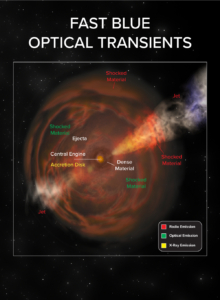Analysis of two cosmic explosions indicates to astronomers that the pair, along with a puzzling blast from 2018, constitute a new type of event, with similarities to some supernovae and gamma-ray bursts, but also with significant differences.
Select :
aasactive galactic nucleusALMAanniversaryARDCasteroidasteroidsAtacamaAtacama Large Millimeter/submillmeter arrayAUIaui programAUI Scholarshipawardsbaselinebinarybinary starsblack holeblack holesblazarBroader Impactsbrown dwarfCaltechcasaCDLcensusCentral Development LaboratoryCepheus acfachandracoma berenicesComa clustercometscosmic explosioncosmologycryoCSOdark matterdead galaxyDecadal Surveydeep fielddeep field imagingdftaudigital backenddistant galaxydiversityearly universeEHTEMSequityeventexoplanetexoplanetsfast radio burstFast Radio Burstsfirst fringesflarefotaufrbfringesfundinggalaxiesgalaxies mergergalaxygalaxy clustergalexgamma ray burstgbogbtgravitational lensgravitational wavesgreen bank observatorygreen bank telescopeH20HAM Radiohelical magnetic fieldhonorsHubbleHugheshvachw2hydrogenimage contestinclusioninternational women's dayIoJansky FellowshipsJansky Lecturejetjet collimationjetsJupiterLeroyLGBTlocal oscillatorlow noise amplifierm83M87magnetarMagnetarsmagnetic fieldsmaserMilky Waymolecular cloudsmoumtexNACnasaNational Astronomy ConsortiumNational Science Foundationnear earth objectsNEOsneutron starsneutron-star mergernglcngVLANINENMnraoNRQZNSFNSF NRAOODIopen houseOrionparkes radio observatorypawseypeoplePHANGSplanetary defensePlanetary Radarplanetary scienceplasmaPostdoctoral researchPRIDEprotoplanetary diskprotoplanetsprotostarprotostarsprotostellar jetPROVOCAproxima centauripulsarqorvoquasarradarradio telescoperam pressure strippingraytheonreceiverreceiver upgradeREUrixindustriesSchinnererscholarshipscience casesSETIsgrASMBHsofiasoftwareSolar Systemspectrumspiral galaxiesstar deathstar factorystar formationstarbirthstarsstellar flarestellar nurseriesSTEMsummer researchsupernovasupernova remnanttidal disruption eventstradestradesmenunmupgradeusnovery large arrayvery long baseline arrayviaVLAvla open housevlassVLBAvlbivndawaterxkaxray






